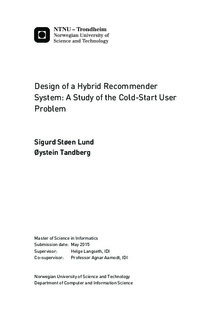Design of a Hybrid Recommender System: A Study of the Cold-Start User Problem
Master thesis
Permanent lenke
http://hdl.handle.net/11250/2352318Utgivelsesdato
2015Metadata
Vis full innførselSamlinger
Sammendrag
Recommender systems are used to help users discover the items they might be interested in, especially when the number of alternatives is big. In modern streaming websites for music, movies, and TV-shows, E-commerce, social networks, and more, recommender systems are widely used. These recommender systems are often looking at the ratings on items for the current and other users, and predicting a rating on the items the user have not seen. Others match the content of an item itself against a user profile. A mix of the two is often used to make the predictions more accurate, and this can also help to the problem when a new user sign up where we have no knowledge about him. This issue, is a well-known problem for recommender systems often described as the cold-start problem, and much research has been done to find the best way to overcome this.
In this thesis, we look at previous approaches to recommender systems and the cold-start problem in particular. We have developed our application, Eatelligent, which is recommending dinner recipes based on our study of previous research. Eatelligent has been designed to examine how we can approach the cold-start problem efficiently in a real world application, and what kind of feedback we can collect from the users.
